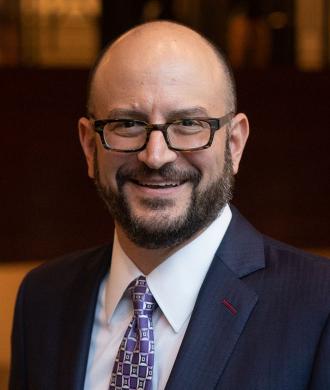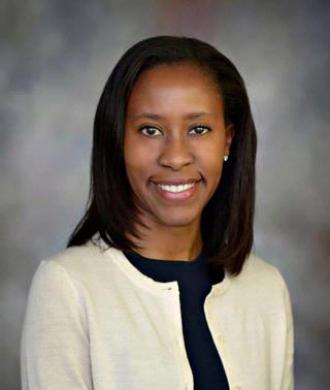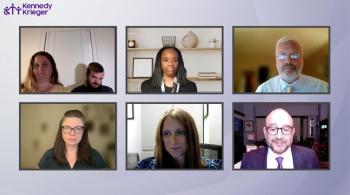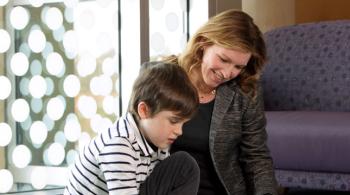On this month's episode rare diseases are discussed. This includes the difficulties in diagnosing these rare disease and the importance of research in developing effective treatments.
Dr. Bradley Schlaggar, president and CEO of Kennedy Krieger Institute welcomes:
- Dr. Ali Fatemi - chief medical officer at Kennedy Krieger Institute and director of the Moser Center for Leukodystrophies and an investigator at the Hugo W. Moser Research Institute at Kennedy Krieger. Dr. Fatemi is also professor of neurology and pediatrics at Johns Hopkins School of Medicine.
- Dr. Erika Augustine - associate chief science officer and the director of the Clinical Trials Unit at Kennedy Krieger Institute, as well as the director of the Batten Disease Clinic at Kennedy Krieger. Dr. Augustine is also an associate professor of Neurology at Johns Hopkins School of Medicine.
Resources
- RareDiseases.org
-
Kennedy Krieger Named Center of Excellence For its Treatment of Rare Pediatric Diseases
Learn More About Our Featured Speakers
Learn More About Our Featured Speakers
View Episode Transcription
Dr. Brad Schlaggar (BS): Welcome to Your Child's Brain, a podcast series produced by Kennedy Krieger Institute with assistance from WYPR. I'm Dr. Brad Schlaggar, pediatric neurologist, the president and CEO at Kennedy Krieger Institute. According to the National Organization for Rare Disorders, there are about 7,000 rare diseases, a significant proportion of which involve the developing brain. In the United States, this population is about 330 million people, each rare disease affects fewer than 200,000. However, in total, these diseases affect an estimated 30 million people nationwide, that's just less than one in 10 people and roughly 300 million people worldwide. Thus, while each rare disease is rare, having a rare disease is relatively common. Since rare diseases are often difficult to diagnose, it can take years to obtain an accurate diagnosis. Even after an accurate diagnosis has been made, specific treatment remains unavailable for most because fewer than five percent of rare diseases have a treatment approved, for example, by the Food and Drug Administration. As a consequence, rare diseases are often devastating, accounting for roughly a third of deaths in the first year of life, and in addition to the morbidity and mortality, they can be exceedingly costly to patients and their families. Today I'm joined by two of my colleagues at Kennedy Krieger Institute who are on the front lines of working to find treatments, specifically disease-modifying treatments for rare diseases affecting the developing nervous system. Dr. Ali Fatemi is the chief medical officer at Kennedy Krieger Institute and director of the Moser Center for Leukodystrophies and an investigator at the Hugo W. Moser Research Institute at Kennedy Krieger. Dr. Fatemi is also a professor of neurology and pediatrics at Johns Hopkins School of Medicine. Dr. Erika Augustine is the associate chief science officer and the Director of the Clinical Trials Unit at Kennedy Krieger Institute, as well as the director of the Batten Disease Clinic at Kennedy Krieger. Dr. Augustine is also an associate professor of neurology at Johns Hopkins School of Medicine. Welcome, Ali and Erika. Erika, let's start with you and some definitions. What is a rare or orphan disease? Are these different concepts, rare and orphan?
Dr. Erika Augustine (EA): A rare disease is any condition or disorder that affects a small number of people. Sometimes you hear often as well and just as you ask, are they the same thing? Are they different? We use those words interchangeably. They generally mean the same thing but often likely emerged out of a concept of vulnerability or abandonment or lack of interest when it comes to research or investment in therapy. Sometimes our policies and our laws talk about orphan diseases or orphan drugs. But in reality, we're talking about rare diseases altogether. That interest issue has been a really important one for a long time.
BS: Ali, given our focus here at Kennedy Krieger, on the developing brain and nervous system. How many rare diseases involve the developing brain?
Dr. Ali Fatemi (AF): That's a very good question, Brad. As you mentioned, is already at least 7,000 known rare diseases, and that on average there is about a couple of hundred that are being discovered every few months. We know that somewhere around 4,000 of them at least will develop in some form or shape the nervous system and so that obviously can involve the brain or the peripheral nerves or the spinal cord and many times it involves the developing brain on the developing nervous system and can present anywhere from a child who comes into the clinic with just developmental delay, or somebody who comes in with a very specific appearance that we would call a syndrome or someone who might come in with severe epilepsy or autism there we then identify an underlying rare disease as the root cause for these presentations.
BS: What are some of the specific examples, Ali? Some of the conditions for example that you might see in clinic.
AF: When we think about rare diseases that come to us, primarily, we think about things that affect the brain. For instance, a very common cause of intellectual disability in girls is a syndrome called Rett Syndrome, which is a genetic disease that presents in young girls and they look normal first at birth and then after the first six to 12 months start losing some skills that they had already gained and often have regression and start having severe seizures and have very specific hand-wringing movements that's very typical for that disease. The most common cause of intellectual disability in males is Fragile X syndrome, which is another genetic disease that affects boys and they usually present with developmental delays and features of autism and can have seizures as well. Another way to think about it is also diseases that are rare diseases that are not primarily affecting the nervous system. Like sickle-cell disease, which is a disorder of red blood cells. Sickle cell disease affects primarily the blood cells but we now know that because of the anemia that they have and the deficiency in red blood cells, they actually have abnormal brain development and can have significant brain disease. We can see it from both sides either primarily a disease that affects the brain or something that affects the entire body or part of the body. But indirectly that involves development of the brain.
BS: The kinds of diseases that you just discussed have been mostly genetic or inherited. Can rare diseases also be acquired or like the result of an injury or other illness for example?
EA: They certainly can be caused by injuries. They certainly can be what we call acquired. Not something that's inherited or a risk factor present at birth, things can happen that come about later. Spinal cord injury is an example of that. Sometimes those rare conditions that are acquired might be related to infections or a post-infectious state. Some people remember something called acute flaccid myelitis that was in the news in recent years during the summers where there were surges and this very uncommon condition. We also see that there are other factors that might relate to infections. The coronavirus has certainly not been rare but in children, there's a specific condition that occurs, multi-system inflammatory syndrome in children, or MISC for short, and that is rare. It's a rare consequence of the coronavirus pandemic that we've seen. Many people know people who have had brain tumors. Each individual type of brain tumor is considered rare. I mentioned when we were talking about what is a rare disease earlier, that there's a regional context or each country has its own definitions but that even goes into how diseases occur. There are some conditions that are very common in some places that might be very rare in others, malaria comes to mind parts of the world where malaria is pretty common. Here in the United States, really, it's very rare that you see very few people who experience malaria. There are many other examples like that as well.
BS: When we talk about rarity does that necessarily translate to severe or fatal? Erika, what do you think?
EA: Not all rare diseases or fatal, but certainly they tend to be serious, severe, chronic illnesses. You mentioned that they're a leading cause of childhood deaths, particularly at very young ages and many rare diseases are associated with shortened lifespan. But even beyond that, we know that these are conditions that require medical attention and that they often require medical attention over number of years in a chronic state. They're really important and significant conditions even though any one disease affects relatively few people.
BS: I mentioned at the outset that it's collectively somewhat common to have a rare disease. Can you comment further on that? The notion that while individual rare diseases are rare collectively, it's relatively common.
EA: Very common. One in 10 people has a rare disease of one sort or another. I do think it's important for us to think about rare diseases, both individually and collectively. The scientific knowledge that we have, the information that we need to know to provide care and to give guidance to patients at a lot of that has to do with the specific individual disease. But when it comes to what it means to be a person who is impacted by a rare disorder, trying to access care, trying to find expertise and the resources needed, or for a rare disease the challenges that are faced in trying to create new treatments. Collectively, rare diseases share a lot of those same issues and barriers. We need to look at both the individual and the collective.
BS: Ali, can you tell us maybe as a story about a child, maybe a patient that you've interacted with who has an orphan, a rare disease, who's right now hoping for treatment or cure and the problems that real life, real-world problems that the child might have as well as their family.
AF: Sure. I can tell you many stories and more often that comes to mind right away is this little girl who was born as a beautiful, appearing baby and developed quite well. Learned to sit at six months, learned to crawl at nine months, started walking at one year, started running around. Just around that same time after an infection as simple as the viral infection started becoming more clumsy and running into walls, falling down often, and started complaining about pain. She'd get very tired, she went out of energy and it was very hard to pinpoint what was wrong with it because you're so young. She was evaluated by multiple doctors and multiple specialists and eventually ended up taking pictures taken off her brain and they saw something very abnormal and eventually saw a neurologist who knew what that could be and did the right genetic testing and pinpointed a diagnosis of disease that she has. There's not even a point to mention the name because it's less than 100 people that we know of who have it and it's a super rare disease. But it's a genetic disease and at the time, there was really nothing, known other than what is the gene that's involved in this disease and how it can present in some individuals with no therapies and no intervention. The parents were left quite hopeless. We're searching around and long story short about six years ago, we started together with my research program here, where they initially raised some money to build an animal model for this disease and model that would mimic this disease. That would be something that would help us to understand the mechanisms involved in this disease but at the same time also use it as a test bed to test therapeutics. Fast-forward now, she's a teenager. She has some disability. She has walking challenges and she needs to have some support when she walks around. She's in high school now in ninth grade. We have meanwhile raised together with this family and others millions of dollars to start a serious research program on this disease and have now developed what we call gene-targeted therapies for these diseases that are still in the what we call pre-clinical stage. Still or not in patients, but being tested in model systems. We are hoping that we're going to start clinical trials for the next 2-3 years.
BS: Before we dive into the discussion about the drug development after you do work through the basic science and the animal model development I just wanted to get back to as you told the story, you mentioned that there was an infection that was associated with the onset. I can imagine listening to this, somebody thinking, well it's a genetic disorder. How do you know it's not the infection that caused the problem? How might that work, Ali?
AF: That is the challenge in genetic diseases often that they masquerade themselves as something that we think is different. It's not uncommon actually for many genetic diseases that involve the metabolism in the body, that they will be induced or they will have an exacerbation following an acute illness. It can be as simple illness like a flu or a urine tract infection or diarrhea that basically resolves in a metabolic decompensation, a normal person to be able to tolerate it but if you don't have the right set of metabolism, you will start presenting with symptoms. This was exactly the case here.
BS: Erika, listening to Ali describe that the journey that this young person has been on and how it has led to the development of potential interventions can you talk about what's involved in developing a treatment for a rare disease? Maybe explain the steps that are taken to get a drug. The precursor to getting to a drug or some intervention all the way to the market for patients.
EA: There's so much that's involved. When I hear Ali talk about this patient, this young girl, and her family, they're really on a journey. For her, that journey involves an exceptionally rare disease where a lot may not be known. When it comes to therapy development, it really starts with an idea and an idea for a therapy or intervention that might work but before you can get to the idea, you need to understand the disease a little bit. Sometimes in rare diseases, sometimes there's a lot that's known but sometimes in very rare diseases, there really may not be such knowledge known. That first step may not even be the therapeutic idea. It may be some fundamental work in developing, Ali like you said, animal models in developing better understanding of the disease and what causes it, or what we might call mechanisms or pathways that are impacted. When you have a little bit of that knowledge you can then look at those pathways and think about ways to fix what might have gone astray. Once you have that idea and you have a way to impact that either with a chemical or with attempts at gene correction you test that in cell models or animal models you look at what the right dose might be, what the impact might be a toxicity. Once you have enough information or enough understanding about that therapeutic idea, you then start to see, are you ready? Is it safe or not? Is it a good enough idea to move that into people? Because you really only want to move your best ideas, the ones that you think you have the most reasonable risk safety profile into people. The FDA gets involved. We engage with the FDA when it comes to thinking about trials and people and their readiness for trials and people. When we get to those clinical trials, we still have a lot of the same questions. How much of a therapy should we give? What's the right dose? What's the right timing? How safe, how effective, and how long in terms of effectiveness, these are all the questions that are answered in a series of trials. Again, when you've got enough evidence that this was a great idea with great benefit, then you're able to move on to having an approved therapy. That whole process takes quite some time.
BS: It's a complicated process that has a lot of participants. People like the two of you, for example, doing the front-end work leading to the ideas that could potentially lead to the interventions, Erika, can you take us through who are all of the key players in creating disease-modifying interventions for rare disorders?
EA: There are a lot of partnerships. Everyone has the potential to play a unique role. Some people play many roles, or some entities play many roles. Often in the academic setting, there are real strengths and actually just what Ali was talking about, understanding the disease, building the models, creating the ideas for those therapy interventions. Really getting that pretty far forward before moving into testing an idea in people to see if that's beneficial. Sometimes in the academic setting, we actually are able to translate from animal work all the way into people but sometimes we have partners in that, that was, partners may come from the pharmaceutical industry. They may come from research foundations or other developers as well to be able to move that forward in a way that can be what we call scaled. It's one thing to have an idea. It's another thing to create a program that can potentially get an effective treatment to every person who would benefit from it. There's a real complementary nature of the expertise in academia and that in the pharmaceutical industry. All along the way, patients, families, foundations play a really key role in helping to understand what's important, how pressing is the need, what are the kind of symptoms that matter the most, and really making sure that a whole program is designed in a way that makes sense. All of those individuals, along sometimes with the federal government or state government, have the opportunities to support in different ways or to finance in different ways, the development and these novel therapies as well. It really takes a variety of players to move any one idea forward.
BS: Kennedy Krieger Institute, obviously, we have a research institute, as I mentioned, and are very much involved in this important direction. Ali maybe unpack how do organizations like ours support the critical research that's necessary for developing interventions for rare diseases?
AF: That's a very again critical issue to discuss. Our institution might be an example as to how that can be done. We for example support by starting to actually training professionals in rare diseases and raising awareness amongst professionals about rare diseases. That's the very first step. That has to be the part of this. If people don't know what they don't know, they won't be able to even more commonly they'll make the right diagnosis. It really starts there. Then we have built an infrastructure. This infrastructure is really necessary. Dr. Augustine is probably the most important part of this infrastructure right now where we actually can provide support for investigators who want to study rare diseases. That support comes from providing them opportunities and resources to do basic research like having equipment and tools and spaces and the expertise to, for instance, study stem cells of patients or study animal models and conduct research in those models. At the same time and equally important is to train individuals and provide them support to conduct clinical research. You see, part of the problem with rare diseases is because they are rare we often don't know what the severity of the disease can be and what the disease cause can be. We really need to first before we go into treating patients with a drug for a trial, we need to know what are we going to be looking out for. That is where understanding the outcome of a disease is really critical. Building an infrastructure that allows you to use, say, psychological testing or specific quantitative testing like MRIs or motor testing is really critical to contact this type of research. These are all infrastructures that have to be built for an institution to be able to conduct rare disease research.
BS: You both have commented already on funding. Ali, let's talk about why funding is so necessary and what are the real-world barriers for getting the amount of funding that is needed to make progress.
AF: Yeah, so as I just mentioned, all these things, the infrastructure to conduct this research, this is very expensive. Doing research is very expensive. It costs millions of dollars if you want to study just basic stem cell mechanisms and how mechanisms are happening in a disease at the same time. It's also very expensive to conduct clinical research where you have to potentially have patients travel across the country and bring him on site for several days and so on. We are highly dependent on funding to do this. It really takes an infrastructure and a whole village to really move these rare diseases forward. Therefore, we need money. Part of the challenge that we have is because things like the diseases that were more like I mentioned, Rett Syndrome, Fragile X, for instance, are rare. People are not aware of them. There is a need for advocacy so that we can actually raise awareness so that people understand and this is important and that's why we need to contribute. That's across the board. For example, the National Institute of Health has a very limited budget to study the natural disease courses or what we call Natural History in these rare diseases. They have a very limited budget for that, but that's critical. We can't really do a clinical trial without that. We often are highly dependent on foundations and advocacy groups and donations that will fund this type of research. The type of research that's really critical, but is not necessarily given priority by the regular funding agencies.
BS: It's a great segue to the top. Actually, Erika already talked a bit about the role of patients and families in the research enterprise. But in common disease, people with a common disease don't necessarily have to participate in research because, well, there are many other people who might be able to. But in rare disease, so often, patients and their families not only are dealing with the burden of the disease but also the burden of participation. Erika, can you comment more on the role that patients and families play in this effort?
EA: It is a bit different than the experience of having a common disease where you walk into any office or you talk with any friend or colleague and they're likely to know or at least have heard of what might be happening with you or within your family. In rare diseases, that's not always the case, that's often not the case. One of the key contributions and it may be an unfair responsibility, but it's raising awareness. Raising awareness about the condition, about what it is. Being able to help educate and point people in the right direction once you're knowledgeable. Then there are many opportunities to contribute in small ways and large that may be answering a survey, to participate in research, to help understand what's happening with you or with your family member in terms of how the disease unfolds. That may be actually participating in a research study where you go someplace in person or have a virtual visit, may provide samples, or specimens for research or for study. You may help design some of those studies and provide that kind of input. Many families actually help fund research. That's one of the greatest financial investments that can be made, is to actually provide seed money to help researchers get started in a new direction or an early career investigator launch a career that's focused on the disease that's of interest to any again, one Foundation or family. They're really all kinds of ways to contribute all the way through therapy, approvals, and through policy making. There are even opportunities at the government level, be it state or federal, and with our regulatory bodies to provide input and to be able to provide commentary on major decisions that are made. Everything from making sure that your doctor is informed about your disease if needed, all the way to working with regulatory bodies at the national or even international level and everything in between those opportunities.
BS: There have been some recent wins. I've been in child neurology for a little bit longer than you guys have. There are some diseases that have had wins. That early on, I really did not have a lot of optimism for, I guess maybe Ali take us through some of those recent wins for rare childhood-onset neurological diseases.
AF: Yeah, I too, I'm not that young anymore and I think all three of us in fact remember very well a disease called spinal muscular atrophy, where this was a terrible, deadly condition affecting young children and infants, basically losing older muscle function and dying off of respiratory failure after a few months of life. I follow several patients in the past who would die of this disease. A few years ago we got two therapies that are now effective and approved for this disease. They're both gene-targeted therapies. One is called antisense oligonucleotide therapy and the other one is gene therapy where we basically bring in the deficient gene into the body of these children. Another condition, I can tell you that was a very recent approval is a disease that I personally have been working on for many years called Adrenoleukodystrophy, which was another deadly disease affecting young boys, leading to death after symptom onset within a couple of years. We now have an approved product. Again, another gene therapy approach where we fixed the genetic defect outside the body of these boys and give them back their own cells. There are many trials happening as we speak and many of these really deadly, fatal disorders are becoming treatable as we speak. There's a lot of optimism there.
BS: Lots of optimism and it is really a different landscape than really just 10 years ago or so. But one of the issues that comes with these treatments is that they are costly. Erika, I think a straightforward issue is whether the costs for treatment exacerbate disparities that exist in terms of access to care, access to these new treatments. Can you comment on a new perspective on issues around disparities related to these interventions?
EA: This is an area where we don't yet have a lot of data, a lot of concrete knowledge. We certainly can extrapolate, and we can use common sense approaches to thinking about these issues. Extrapolating, you know disparities exist in virtually every aspect of medicine. It would be logical to extend that to this context where most issues that we see in medicine are actually exacerbated in the rare disease context because of all of the challenges that we discussed before. I certainly expect to see, unfortunately, disparities. There may be a few different kinds of issues at hand. You mentioned cost, to certainly, that is one of these issues. New drug approvals for rare diseases, they typically come with a very high price tag. Now, generally, as we started with many conditions that are considered rare, don't have available effective treatments. When there is a new therapy approved, there might be a little bit more likely to be covered by insurance or at least partly covered by insurance because it is the option. There isn't a plan B, it is the option and they are typically quite effective or often are quite effective. That is a positive, but that coverage may not extend all of the wraparound and additional care that is needed or the out-of-pocket costs that come with many visits that sometimes are required for that. Even this cost alone is one major issue and risk for disparity. But another one is access. Ali, you talked about a new drug approval that involves taking cells out of the body, modifying them, and then returning them to the person. It's a highly specialized approach and that's an approach that's not going to be available absolutely everywhere, especially right after an initial approval. There may be certain centers, certain geographic locations where these therapies are available. That just again, is an access issue, exacerbates known disparities. There really is a lot that we have to learn. There are groups that are working on issues of diagnosis, issues of access. There's a rare disease diversity coalition led by Linda Goler Blount that is very active and is really trying to address some of these issues, obtain the data and create some of those solutions.
BS: Well, we will provide on the page for this podcast episode links to information relevant to these points, to resources to understand more about rare disorders and what we all can do to help advance the success in treatment for them. Thank you so much to this month's guest and to our listeners we hope you have enjoyed this discussion as much as we have, and found the information we've shared interesting and helpful. We hope you'll share this podcast with your friends and consider rating it as well. Please check out our entire library of topics on Your Child's Brain at WYPR.org, KennedyKrieger.org, WYPR.org/Studios or wherever you get your podcasts. You've been listening to Your Child's Brain. Your Child's Brain is produced by Kennedy Krieger Institute with assistance from WYPR and producer Spencer Bryant. Please join us next time as we examine the mysteries of Your Child's Brain.


















